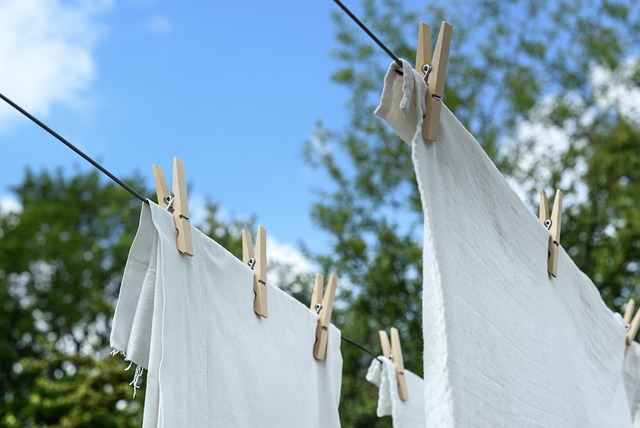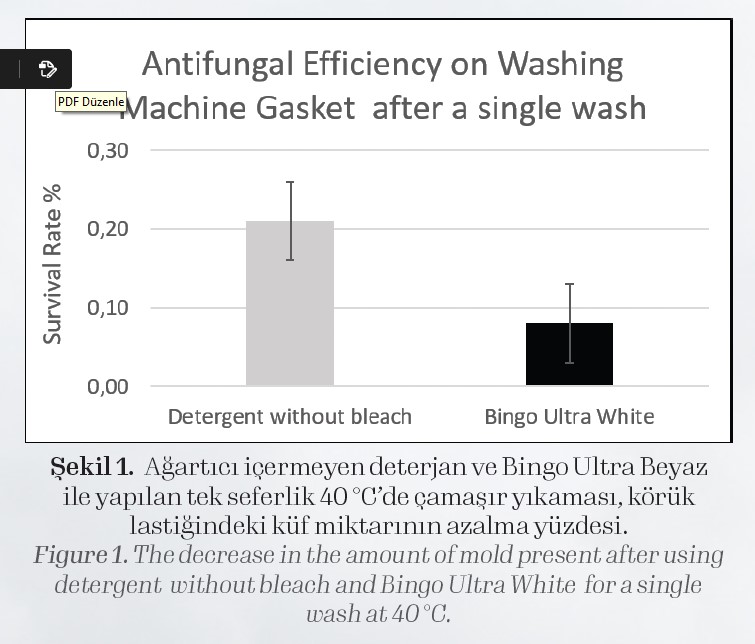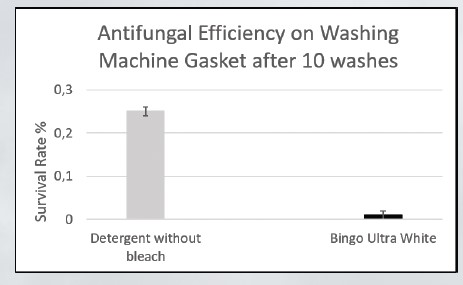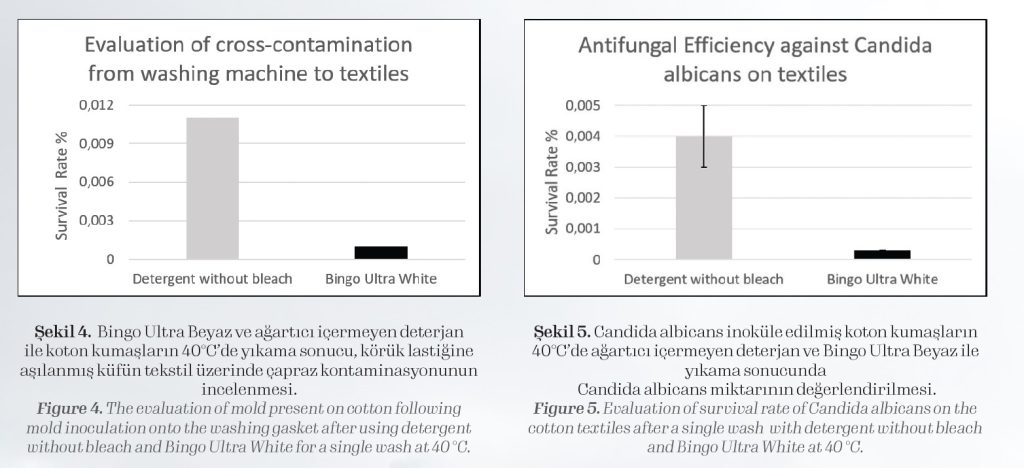Impeccable Laundry Hygiene - Protection Against Hidden Germs Keep Your Clothes and Machine Fresh and Clean
In 1987, Hayat Kimya expanded its operations into the home care products market, after previously operating solely in the fast consumption products sector. Since then, we have established ourselves as a global player in the industry, and our journey continues.
Established in 2012, Hayat Kimya R&D center has been instrumental in accelerating our business in the sector by driving innovation in our products.In 2015, our R&D center was recognized as the top R&D center in Turkey.
Hayat Kimya’s home care brand is expanding its global reach through a robust export network that spans across various regions of the world. Bingo, which is the leading brand in the powder detergent category, remains available to consumers in various regions of the world.
Bingo is located on the market shelves with powder detergent variants such as for white, colorful , colorful & white garments and perfume-free. The main raw materials that affect the stain removal performance in the powder detergents are considered as surfactants, enzymes and bleaches.
While the surfactant and enzyme contents are found in all Bingo Matic powder detergents, the bleach amount is the highest in Bingo Matic Ultra White formula which is designed for white garments. In powder detergents, sodium percarbonate and TAED are mostly used as
bleaching mechanism. This bleaching mechanism is effective on colourful stains like tea, coffee, wine, fruit juice, etc. as well as maintain whiteness of the white garments for a long time.
Furthermore, our recent R&D studies have revealed that the bleach level in the Bingo Matic Ultra White formula supports its antifungal and biofilm preventive properties, even at lower washing temperatures such as 40 degrees. This study presents comprehensive information on how our product can prevent antifungal growth and cross-contamination, as well as protect machines and textiles, even when used at lower temperatures.

Introduction
While the primary goal of laundering is to eliminate stains and dirt from used and worn textiles, the removal of microbial contamination and malodorous substances from
textiles and washing machines is a significant objective of laundry process as well.
Industrial and institutional laundering utilizes standartized procedures, using 60°C and above temperatures and potent bleaching agents to guarantee a complete hygienic restoration of textiles. However,domestic laundering procedures are often obscure and not
regularly guided by calculated objectives.
The aim to be more energy-efficient of household appliances has led to a reduction in washing temperatures (40°C instead of 60°C) in Europe during the last decades. In
addition, liquid detergents became more popular due to their convenient feature that bleach-free products can affect the ability of domestic laundering to kill microbes.
When it comes to laundry , two significant sources of contaminants have to be considered. The human body serves as the primary source. The microbiota present in the skin or skin pathogens ,which can be transferred to the textile during wearing or usage.
In addition, textiles that have been soiled with potentially contaminated susbtances are another source of microorganisms associated with humans. Hard-toreach wetted parts of the washing machine, such as the rubber ring, are susceptible to biofilm formation, where microorganisms such as fungi are colonized.
Combatting Biofilm Associated Fungal Growth in Washing Machines
The concept of a biofilm refers to a population or community of microorganisms that attach on a surface and display alterations in their physiology resulting from differential gene expression.
Biofilms can form on biotic or inert surfaces and may derive from a single species or be comprised of multiple species. Filamentous fungi can also form true biofilms and that these systems are highly relevant in health and industry. Aspergillus niger has been shown to form biofilms in laundry environments.
The require to remove or deactivate microorganisms in household settings is not only justified by the aim of reducing the risk of infection risk. It also encompasses other adverse microbial consequences, such as malodour formation.
We have shown the antifungal effectiveness of Bingo Ultra White and a standard detergent
on fungi associated with biofilm (Aspergillus niger) on rubber surfaces following a single wash (Figure 1) and 10 washes at 40 °C (Figure 2).
Bingo Ultra White exhibited over 2,5 times greater antifungal activity against mold on the rubber after a single wash , as compared to a detergent without bleach. Furthermore, after undergoing 10 consecutive washings, Bingo Ultra White effectively prevented mold formation on the rubber almost entirely.

[caption id="attachment_150875" align="aligncenter" width="463"]

Figure 2. The decrease in the amount of mold present after using
detergent without bleach and Bingo Ultra White after 10 washes at 40 °C.[/caption]
Prevention of Growth and Cross-Contamination of Skin Associated Fungi
The microbial community asscoaciated with laundry is a mixture of skin-associated microorganism, microorganisms that are ubiquitous in the environment, and the washine machine itself.
Regarding this matter, it is hypothesized that the laundering process results in a transition of the microbial population on the textiles, shifting from primary contaminants (e.g. skin bacteria) to secondary contaminants (e.g. biofilm- associated environmental bacteria).
Candida albicans can potentially be transmitted via insufficiently decontaminated textiles, if the textiles are in contact with areas of the body where Candida infections commonly occur, such as the skin and mucous membranes. To prevent the transmission of Candida albicans via contaminated textiles,it is important to ensure that textiles are properly cleaned and decontaminated using appropriate detergent.
Although cotton can serve as a suitable medium for the growth of fungi , we have demonstrated through SEM microscopy that washing textiles with Bingo Ultra White eliminated Candida from the fabric (Figure 3).

In addition, studies have demonstrated that laundering does not just reduce the number of microbial cells on the textile, but can also introduce microorganisms to a considerable degree. Cotton is the most commonly utilized natural fiber in textiles. Nevertheless,
its high capacity to absorb moisture,retain oxygen, and posses a large specific surface area make cotton fibers more susceptible to microbial contamination.
We have demonstrated that Bingo Ultra White safeguards against microbial transfer from washing machines to textiles (Figure 4) and maintains textile freshness (Figure 5).

Conclusion
According to research, unclean clothes can pose health risks, emit unpleasant smells, and create technical issues in washing machines. With the current focus on energy efficiency, particularly in household appliance, the effectiveness of washing hygiene must be balanced against the use of lower wash temperatures, as the temperature profile can have significant
impact.
Regular use of Bingo Ultra White at 40 degrees has been shown to provide adequate protection during the washing process. In this way, it helps to prevent bad odors and protect both textiles and washing machines.
References
Bloomfield, S. F., Carling, P. C., Exner, M., Gould, D., & Nath, K. J. (2017). Infection
prevention and control in the home: why we need to do more. Journal of Hospital
Infection, 97(4), 339-343.
Bockmühl, D.P. (2017) . Laundry hygiene—how to get more than cleanJournal of
Applied Microbiology 122, 1124--1133
Borrego, A., Ferreira, J. P., Reis, C., Ribeiro, M., & Fernandes, I. (2017). Microbial
contamination in washing machines and associated risks for human health. Environmental
Science and Pollution Research, 24(18), 15209-15225
El-Sherbiny, G. M., Mohamed, E. A., & Abdel-Rahman, H. A. (2018). Antifungal efficacy
of some bleaching agents against clinical isolates of dermatophytes. Journal
de Mycologie Médicale, 28(4), 675-681
Fittipaldi, M., & Codony, F. (2019). Microbial contamination of washing machines
and the role of Candida in laundry hygiene. International journal of environmental
research and public health, 16(10), 1814.
Gao, S., Wang, S., Jiang, D., Feng, J., & Li, J. (2020). Peroxycarboxylic acids: a promising
class of fungicides. Journal of Agricultural and Food Chemistry, 68(4), 1111-
1120.
Gattlen, J.,Amberg, C., et al. (2010). Biofilms isolated from washing machines
from three continents and their tolerance to a standard detergent, Biofouling:
The Journal of Bioadhesion and Biofilm Research, 26:8, 873-882, DOI:
10.1080/08927014.2010.524297
Priegnitz, B. E., Wargenau, A., Brandt, U., Rohde, M., Dietrich, S., Kwade, A., et al.
(2012). The role of initial spore adhesion in pellet and biofilm formation in Aspergillus
niger. Fungal Genet. Biol. 49, 30–38. doi: 10.1016/j.fgb.2011.12.002
Rose, L., Rogan, M., & Kopecki, N. (2019). Laundry and healthcare: an evaluation of
infection control in linen services. Healthcare Infection, 24(1), 23-29. https://doi.
org/10.1071/HI18042
Sandifer, Q. D., Walker, J. T., & McLaughlin, J. B. (2016). A review of microbial contamination
of laundered fabrics and laundering effectiveness. Journal of Applied
Microbiology, 120(4), 982-993
Whitehead, K., Eppinger, J.,Srinivasan, V., Ijaz, M.K.,Nims, R.W.,McKinney, J. Potential
for Microbial Cross Contamination of Laundry from PublicWashing Machines.
Microbiol. Res. 2022, 13, 995–1006. https://doi.org/10.3390
Dr. Ö. Özlem İbrahimoğlu Karamık - Principle Researcher, Biotechnology
Hayat Kimya R&D
Ahmet Ergün - Detergent R&D Group Manager
Hayat Kimya R&D
Gülşah Acar - Principle Researcher, Innovation, Detergent
Hayat Kimya R&D


 [caption id="attachment_150875" align="aligncenter" width="463"]
[caption id="attachment_150875" align="aligncenter" width="463"] Figure 2. The decrease in the amount of mold present after using
Figure 2. The decrease in the amount of mold present after using In addition, studies have demonstrated that laundering does not just reduce the number of microbial cells on the textile, but can also introduce microorganisms to a considerable degree. Cotton is the most commonly utilized natural fiber in textiles. Nevertheless,
its high capacity to absorb moisture,retain oxygen, and posses a large specific surface area make cotton fibers more susceptible to microbial contamination.
We have demonstrated that Bingo Ultra White safeguards against microbial transfer from washing machines to textiles (Figure 4) and maintains textile freshness (Figure 5).
In addition, studies have demonstrated that laundering does not just reduce the number of microbial cells on the textile, but can also introduce microorganisms to a considerable degree. Cotton is the most commonly utilized natural fiber in textiles. Nevertheless,
its high capacity to absorb moisture,retain oxygen, and posses a large specific surface area make cotton fibers more susceptible to microbial contamination.
We have demonstrated that Bingo Ultra White safeguards against microbial transfer from washing machines to textiles (Figure 4) and maintains textile freshness (Figure 5).
